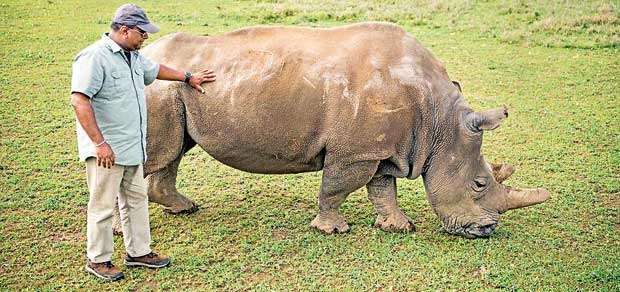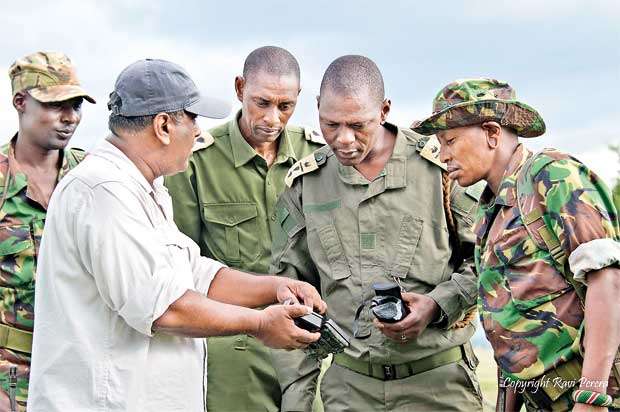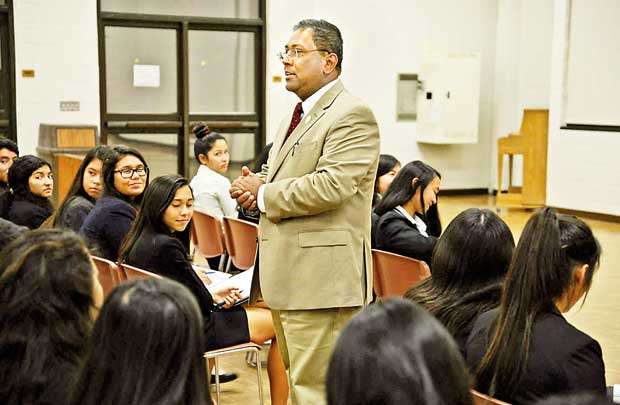Reply To:
Name - Reply Comment

 individuals who were selected to follow training at the Forensic Academy of the Federal Bureau of Investigation in Quantico, Virginia. While solving crimes related to humans, Ravi has quite interestingly extended his expertise to solving wildlife crimes, especially at his work base in Kenya. As such, Ravi is also the founder of the Serendipity Wildlife Foundation which is an organisation that provides assistance in wildlife forensics and investigations. Ravi also has plans to extend his operations to Sri Lanka in the near future.
individuals who were selected to follow training at the Forensic Academy of the Federal Bureau of Investigation in Quantico, Virginia. While solving crimes related to humans, Ravi has quite interestingly extended his expertise to solving wildlife crimes, especially at his work base in Kenya. As such, Ravi is also the founder of the Serendipity Wildlife Foundation which is an organisation that provides assistance in wildlife forensics and investigations. Ravi also has plans to extend his operations to Sri Lanka in the near future.
In an interview with the Daily Mirror during a recent visit to Sri Lanka, Ravi shared his experience in the field of forensics and about lessons we can learn from Kenya.
Excerpts:
My forensic career started 24 years ago and will be completing 25 years in a couple of weeks. The department that I worked for wanted to start a CSI unit. But during that time there was no CSI on TV and no one knew what CSI was. Then I said yes and from that point onwards there was no return. They sent me for schooling which included basic, intermediate and advanced CSI which I studied at the University of California, Long Beach. I also did my advanced certification which very few people have and I got quite interested in it that I did a double advanced certificate as well. I have done almost every type of training available and have been able to solve well over 5,000 crimes from basic vandalism to homicides. My department is one of the few that do traditional CSI including fingerprints, DNA, different types of evidence such as biological evidence, trace evidence, traces from hair or fibre and any type of body fluid. From there I was asked if I would like to be sponsored for the FBI Academy in Quantico. That is the ultimate that anybody could reach. So I asked whether I was qualified and one of my supervisors sponsored me as he thought I should take my education further.
"I think education is very important and the Wildlife and Nature Protection Society (WNPS) is heading in the right direction. Education is the best way to go because in Kenya my drivers need to be certified before they go out there"
Hence, I applied and there were thousands that have applied. The minimum qualification was that you had to have 10 years of experience. At Quantico they don’t just teach the basics but teach everything at a higher level. I applied and for six months I completely forgot about it and gave up hopes when one day they suddenly called me and asked if I was ready to go in three weeks. I was so happy because out of the thousands who applied only 12 were selected from the whole of US. Then I also found out that I’m the only person from the entire state of California that has been selected. It was the most memorable time of my life. I never expected it to be so advanced and there was so much to study. Sometimes classes would start at 6.30 am and would go on till 11.00 pm. The academy alone was bigger than Dehiwela and Mt. Lavinia combined. So you need wheels to go from one end to the other. It has its own crash track where they drive cars, crash it and we have to do the investigation and the photography. Everything was extremely hi-tech. My most exciting time was doing surveillance photography from helicopters and night vision photography which we would do with absolutely no light. Then we had the usual crime scene materials we would photograph including shoeprints, drug detection, surveillance on drug sales where our instructors would be the bad guys and we have to go in and pick our spot to take photographs of the way they come in, the drug transaction, etc.
On one of my visits to Kenya I was talking to people at the anti-poaching unit and I realized that they never had proper evidence when they caught people who were poaching, smuggling or trafficking. Evidence means to show the person associated with the crime or being at the crime scene or involved with the crime in some way. I told them what I do in the US and they invited me back to start working with them. The first thing that they found was that when someone shot an animal they wouldn’t want to get caught with the weapon, so they ducked the gun under a bush. So even if there are 10 people they don’t know who shot at the animal. Hence I introduced what is called Gunshot Residue Testing (GSR) which enables them to take that little testing kit, put it on their hands and detect who had fired the shot. That came in useful and we will enhance it in years ahead. I also taught them fingerprinting which was very useful. We started fingerprinting on tusks and we are still in the process of testing and we found some good methods. The tusks are porous and do not have a smooth surface. If it is a smooth surface we can get a good fingerprint. We started a project and it has proven to be successful and by next year we want to have the first wildlife crime fingerprint database only to associate people involved in wildlife crimes. This is going to be very unique.
That would be a lot of sex crimes and child abuse cases. Sometimes it will be a family member that they don’t want to be arrested or prosecuted or they don’t want to be a witness. If it’s a child then he or she can’t make those decisions. There was a case where a camera was left behind at a crime scene and when I looked at the flash card there were no faces there. But in one of the photographs I saw a finger. So I took it back into the lab, analysed it for a couple of hours and got his fingerprint detail off his finger. It then turned out that this person was identified in a lot of crimes.
There were operations including money laundering and gun trafficking which have been very exciting. But every case can be as exciting as another. In cases such as homicides we have to think like the criminal. I’m also a Shooting Reconstruction Specialist and this is where we have to reconstruct the crime scene with the evidence that we have.
"On one of my visits to Kenya I was talking to people at the anti-poaching unit and I realized that they never had proper evidence when they caught people who were poaching, smuggling or trafficking. Evidence means to show the person associated with the crime or being at the crime scene or involved with the crime in some way"
The most important thing is to preserve a crime scene when a crime happens. The evidence needs to be preserved and from videos and pictures I see in Sri Lanka I don’t see that happening. The whole village, the next village and their relatives are looking down at the accident or dead body.
I also see that in wildlife crime where a 100 people are gathered around a dead elephant. So if the elephant was killed by something we have lost our evidence there. If evidence is contaminated we cannot use it. Contamination means touching, walking in that area and taking evidence out. What we do is to secure it with crime scene tape so that no one can walk in. In that way we support the integrity of the crime scene.
The collection of evidence needs to be done with a plan and a method by qualified people. The qualified people need to know exactly what they are doing and prior experience goes a long way. You also need to make sure that everything is safe when you enter a crime scene and you should enter with the bare minimum number of people.

In most instances they get reported by rangers who go on patrol or by the villagers that do a lot of walking, especially the tribesmen who can walk up to 20 to 30 miles on foot every day. Then again it could be a natural death, it could be caused by another animal or it could be a shooting.
Sometimes we find animals hanging from snares and when it comes to snares it’s quite difficult to find a suspect. One of the key pieces of evidence we collect is from the cell phone. There is software that we use to extract evidence and do cell phone analysis and the information we get can be used as evidence to solve the crime. They can have a locked cell phone and delete files but we can still retrieve information.
Let me take an example about lions because lions are the animals that tend to affect people in Kenya the most. There is a programme in place right now where donors put money into a certain fund and if their cow is killed by a lion they get compensation. So they are not keen on killing the lion anymore. But sometimes they want to kill the lion because the cows, goats and sheep are valuable to them. Lions are the big killers, and this compensation programme has gone a long way and it has been implemented in tourism areas.
Compensation could work if the elephants destroy crops but where is this money coming from? It is very rarely that houses get damaged in Kenya and the cost of constructing a hut is quite cheap. In Sri Lanka, the farmers are not contributing to tourism as such. But the Masai warriors contribute because they are in the tourism area and tourists even visit their village. The money comes from lodgers, well-wishers and foundations who are interested in conservation. Because if a lion is killed, a luxury camp will not have their guests coming in, so they value the animal because that is part of their wealth.
I think education is very important and the Wildlife and Nature Protection Society (WNPS) is heading in the right direction. Education is the best way to go because in Kenya my drivers need to be certified before they go out there. Sometimes they may have to go to a guiding school for two years before they can be certified as a safari driver. You got to know exactly what you’re doing, how you behave and even identify every animal and bird out there. But in Sri Lanka, I have had trackers who have never opened their mouth during the entire safari ride. That was when I realized that I don’t need trackers but I can get the support from the jeep driver. Some of the jeep drivers are not qualified and know nothing about wildlife. So they can go in for a certification programme and perhaps have a sticker on their jeeps for guests to identify them as qualified drivers. and we don’t have 100 to 200 jeeps coming in at once. Hence there’s no blocking and there’s space for everyone.
"The most important thing is to preserve a crime scene when a crime happens. The evidence needs to be preserved and from videos and pictures I see in Sri Lanka I don’t see that happening. The whole village, the next village and their relatives are looking down at the accident or dead body. I also see that in wildlife crime where a 100 people are gathered around a dead elephant. So if the elephant was killed by something we have lost our evidence there. If evidence is contaminated we cannot use it "
That is if there is wildlife remaining for the future and if nothing is done right now, there won’t be any wildlife in the future. If all the elephants get killed there will be nothing for the future generations.
From what I read I don’t see any positive outcomes. I don’t live in Sri Lanka so I don’t have first-hand experience; I don’t go out to the jungles as a lot of conservationists or wildlife lovers do. I think it’s good that there are associations and individuals who have come forward to fight for the wildlife and be their advocate and that in turn makes a big difference.
